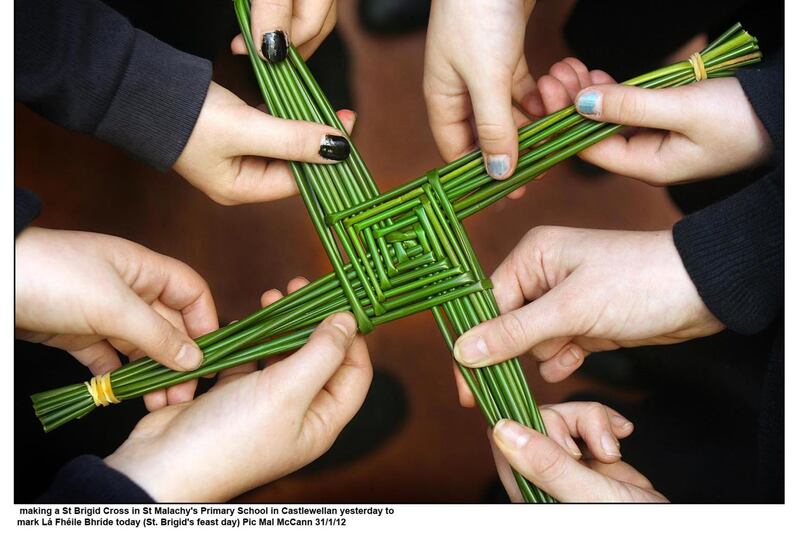IN 2011, the Irish Chaplaincy in Britain, in keeping with its work on behalf of some the most vulnerable and marginalised Irish people in Britain, decided to adopt St Brigid as its patron saint.
The choice was well made. Brigid of Kildare ('Mary of the Gael') may have lived in the fifth century, but she was a woman well ahead of her time.
Far from being a figure consigned to folklore, she emerges as someone who has much to say to us today about such contemporary concerns and issues as care for the earth, work for peace and justice, equality, as well as being a model for the contemplative life.
The bare facts of her life are soon told. She was born at Faughart, near Dundalk, Co Louth, in 452, the daughter of parents who were baptised by St Patrick with whom she developed a close friendship.
Despite receiving many offers of marriage, she become a nun and with seven others settled at Croghan Hill for a time before following St Mel to Meath.
There is a tradition that she took her vows from St Mel around 468. Brigid may well have been the only female bishop of the early Celtic Church, for it is said that upon receiving her vows, St Mel was inspired by God to make her a bishop.
Sometime around 470, Brigid moved to Cill Dara (Kildare), where she founded a 'double monastery' - one for men and one for women - over which she ruled as abbess.
She appointed St Conleth as bishop, and between them they governed their church by means of a mutually happy alliance establishing a practice which was to last for centuries of a double line of abbot-bishops and of abbesses, with the abbess of Kildare as the first among equals.
Brigid was one of the most remarkable women of her time and despite the legends and myths surrounding her name, she emerges as a strong and gentle woman, a powerful leader, a skilful healer and wise spiritual guide
Given today's controversies surrounding issues of equality over women priests and bishops, we surely have much to learn from this model of governance in the early Celtic church.
Brigid died at Kildare in 525, leaving a cathedral city and school that became famous all over Europe.
Brigid was one of the most remarkable women of her time and despite the legends and myths surrounding her name, she emerges as a strong and gentle woman, a powerful leader, a skilful healer and wise spiritual guide.
She has become for many a potent symbol of Christian womanhood, showing us in different ways the feminine face of God.
What makes her particularly relevant for us today is the range of issues she embraced and the manner in which she dealt with them.
She was a peacemaker who intervened in disputes and brought healing and reconciliation.
Folklorists tell us that in some parts of Ireland, St Brigid's Cross was often used as a token of friendship after a local quarrel.
One story tells of her giving away her father's precious sword to a poor man so that he could barter for food to feed his family, thus transforming a weapon of war into a life-giving instrument.
In Brigid's life, the active and contemplative lived in harmony. She was no stranger to hard work and there are stories of her milking cows, making butter, shepherding her sheep, helping with the harvest and even brewing the ale.
But she was also a woman of contemplation, given to long hours of prayerful reflection from which she drew her spiritual strength, confidence and courage.
A Life of Brigid, composed sometime around 650, places great emphasis on her faith, her healing powers, her hospitality, and her compassion for the poor and oppressed.
In keeping with her Celtic traditions, Brigid was wonderfully attuned to the seasons and cycles of nature.
It is no accident that today many individuals and groups concerned about the environment and our treatment of the planet draw inspiration from the reverence and respect which she had for the wonder of creation.
Thanks to the influence of people like the late John O'Donoghue, recent years have seen a great resurgence of interest in all aspects of Celtic theology and spirituality, leading many people to rediscover and draw inspiration from the lives of the early Irish saints.
St Brigid, the patroness of Ireland, is emerging as one whose life has relevance and inspiration for us today as we confront the great issues in our society and our world. Truly, a woman for our times.
- Fr Gerry McFlynn is a priest of the Diocese of Down and Connor, project manager at the Irish Chaplaincy in London and a vice president of Pax Christi, the international Catholic peace movement.






